Geographies and Scientometrics of Research on Natural Hazards
Abstract
1. Introduction
2. Data and Methods
2.1. Web of Science Database, Classification of Natural Hazards, and Dataset Building
- Major types of natural hazards (over 40,000 research items found; four major types of natural hazards for each of category–climatic/hydro-meteorological (FL, ST, DR, HU) and geological/geomorphic (EQ, SM, ER, VO)).
- Other types of natural hazards (between 4000 and 40,000 research items found; two other types of geological and geomorphic natural hazards (SU, TS), six other types of climatic hydro-meteorological hazards (SR, WF, DE, HW, TO, DS)). Other types of natural hazards are grouped into one category for some of the analysis (CO, GO; see Section 2.2).
- Not considered types of natural hazards (natural hazards not reaching the threshold of 4000 research items at WOS (1900–2017) are not considered in this study). These are, for example: shifting sand (TS = (shift * AND sand); 3127 research items), blizzard and snowstorms (TS = (blizzard * OR snowstorm * OR (snow storm *)); 2704 research items), hailstorms (TS = (hailstorm * OR (hail AND storm *)); 1289 research items), lahars (921 research items),…).
2.2. Dataset Analysis
2.3. Databases of Disasters
3. Results
3.1. Research on Different Types of Natural Hazards
3.1.1. General Trends
3.1.2. Multi-Hazard Research Items and Links Between Types of Natural Hazards
3.2. Geographical Focus of Research on Natural Hazards
3.3. Research by the Countries of the Authors (Affiliations)
3.3.1. General Overview and Research in Top 10 Research Countries
3.3.2. Cooperation between Countries
3.4. Citations
4. Discussion: Research on Natural Hazards and Reported Disasters—Global Overview
4.1. Research on Natural Hazards and Their Occurrence in Time
4.2. Research on Natural Hazards and Fatalities Caused
4.3. Research on Natural Hazards and Losses Caused by Natural Hazards
5. Conclusions
- Research on climatic/hydro-meteorological hazards is prevailing over the research on geological/geomorphic hazards globally (55.8%/44.2%), while significant differences exist between individual countries, reflecting the main types of natural hazards affecting these countries.
- The total amount of research items published is increasing exponentially for all types of natural hazards, with over the half of all research items published in 2010–2017 (analyzed period 1900–2017).
- In terms of the total number of research items published, leading hazards are floods, earthquakes, storms, and droughts; the share of individual types of natural hazards in research on natural hazards is rather stable over time.
- Research on all types of natural hazards is dominated by researchers from the USA, followed by researchers from China; the list of top 10 research countries for individual types of natural hazards further includes England, Japan, Germany, Italy, France, Australia, Canada, India, Spain, Taiwan, Russia, Switzerland, and The Netherlands.
- The majority of research items are written by the author(s) from one country; strong cooperation in natural hazard research exists between the top 10 research countries and geographically neighboring countries; two clusters of cooperation in natural hazard research are revealed—European and circum-Pacific.
- The analysis of geographical focus reveals hotspots of natural hazards research (USA, China, Japan, Australia, Canada, Italy, India; > 10,000 research items focusing on each country), as well as hotspots of a limited amount of research on natural hazards in Africa and Central Asia.
- Research on heat waves and volcanic activity obtained the highest average number of citations per research item (24.8 and 23.9 citations/item), while research on tornadoes and tsunamis yielded the lowest (9.9 and 11.6 citations/item).
- The exponentially increasing amount of published research items does not correspond with the number of events reported, or fatalities or losses claimed (linear increasing trend; based on two global databases of natural disasters), rather indicating a changing paradigm in publishing in natural hazard science and/or possible other motivation for research on natural hazards (changing policies, funding priorities).
- The share of research on climatic/hydro-meteorological hazards and geological/geomorphic hazards roughly corresponds to the share on the total number of fatalities claimed, but not damages caused globally (dominance of climatic/hydro-meteorological disasters).
- Major disasters such as the 2004 Indian Ocean tsunami or 2008 Wenchuan earthquake are capable of imprinting into the global statistics of research on individual types of natural hazards.
Author Contributions
Funding
Acknowledgments
Conflicts of Interest
References
- MunichRE NatCatSERVICE. Available online: https://natcatservice.munichre.com/ (accessed on 18 October 2018).
- Hewitt, K. Environmental disasters in social context: Toward a preventive and precautionary approach. Nat. Hazards 2013, 66, 3–14. [Google Scholar] [CrossRef]
- Intergovernmental Panel on Climate Change (IPCC). Contribution of Working Group I to the Fifth Assessment Report of the Intergovernmental Panel on Climate Change; Cambridge University Press: Cambridge, UK; New York, NY, USA, 2013; 1522p. [Google Scholar]
- Birkmann, J. Measuring Vulnerability to Natural Hazards; United Nations University Press: New Delhi, India, 2006; 524p. [Google Scholar]
- SwissRE Sigma Explorer. Available online: http://www.sigma-explorer.com/ (accessed on 18 October 2018).
- DesInventar—Inventory System of the Effects of Disasters. Available online: https://www.desinventar.org/ (accessed on 18 October 2018).
- Chiu, W.T.; Ho, Y.S. Bibliometric analysis of tsunami research. Scientometrics 2007, 73, 3–17. [Google Scholar] [CrossRef]
- Sagar, A.; Kademani, B.S.; Garg, R.G.; Kumar, V. Scientometric mapping of Tsunami publications: A citation based study. Malays. J. Libr. Inf. Sci. 2010, 15, 23–40. [Google Scholar]
- Liu, X.J.; Zhan, F.B.; Hong, S.; Niu, B.B.; Liu, Y.L. A bibliometric study of earthquake research: 1900–2010. Scientometrics 2012, 92, 747–765. [Google Scholar] [CrossRef]
- Qian, G. Scientometrics Analysis on the Research Field of Wenchuan Earthquake. Disaster Adv. 2012, 5, 704–707. [Google Scholar]
- Wu, X.L.; Chen, X.Y.; Zhan, F.B.; Hong, S. Global research trends in landslides during 1991–2014: A bibliometric analysis. Landslides 2014, 12, 1215–1226. [Google Scholar] [CrossRef]
- Mikoš, M. The bibliometric impact of books published by the International Consortium on Landslides. Landslides 2018, 15, 1459–1482. [Google Scholar] [CrossRef]
- Emmer, A. GLOFs in the WOS: Bibliometrics, geographies and global trends of research on glacial lake outburst floods (Web of Science, 1979–2016). Nat. Hazards Earth Syst. Sci. 2018, 18, 813–827. [Google Scholar] [CrossRef]
- Clarivate Analytics Web of Science. Available online: www.webofknowledge.com (accessed on 18 October 2018).
- Burton, I.; Kates, W.R. The Perception of Natural Hazards in Resource Management. Nat. Resour. J. 1964, 3, 412–441. [Google Scholar]
- Wisner, B.; Gaillard, J.C.; Kelman, I. The Routledge Handbook of Hazards and Disaster Risk Reduction; Routledge, Taylor and Francis Group: London, UK; New York, NY, USA, 2012; 875p. [Google Scholar]
- Gill, J.C.; Malamud, B.D. Reviewing and visualizing the interactions of natural hazards. Rev. Geophys. 2014, 5, 680–722. [Google Scholar] [CrossRef]
- Hsieh, H.F.; Shannon, S.E. Three Approaches to Qualitative Content Analysis. Qual. Health Res. 2005, 15, 1277–1288. [Google Scholar] [CrossRef] [PubMed]
- Van Eck, N.J.; Waltman, J. Software survey: VOSviewer, a computer program for bibliometric mapping. Scientometrics 2010, 84, 523–538. [Google Scholar] [CrossRef] [PubMed]
- Waltman, L. A review of the literature on citation impact indicators. J. Infometrics 2016, 10, 365–391. [Google Scholar] [CrossRef]
- Hirsch, J.E. An index to quantify an individual’s scientific research output. Proc. Natl. Acad. Sci. USA 2005, 102, 16569–16572. [Google Scholar] [CrossRef] [PubMed]
- Kron, W.; Steuer, M.; Low, P.; Wirtz, A. How to deal properly with a natural catastrophe database—Analysis of flood losses. Nat. Hazards Earth Syst. Sci. 2012, 12, 535–550. [Google Scholar] [CrossRef]
- Wirtz, A.; Kron, W.; Low, P.; Steuer, M. The need for data: Natural disasters and the challenges of database management. Nat. Hazards 2014, 70, 135–157. [Google Scholar] [CrossRef]
- World Population Review. Available online: http://worldpopulationreview.com/countries/ (accessed on 18 October 2018).
- United Nations Statistics Division, Environmental Indicators—Total Area. Available online: https://unstats.un.org/unsd/environment/totalarea.htm (accessed on 18 October 2018).
- The World Bank Data—GDP Stats. Available online: https://data.worldbank.org/indicator/NY.GDP.MKTP.CD?year_high_desc=true (accessed on 18 October 2018).
- Wuchty, S.; Jones, B.F.; Uzzi, B. The increasing dominance of teams in production of knowledge. Science 2007, 316, 1036–1039. [Google Scholar] [CrossRef] [PubMed]
- Sandstrom, U.; Van den Besselaar, P. Quantity and/or Quality? The Importance of Publishing Many Papers. PLoS ONE 2016, 11, e0166149. [Google Scholar] [CrossRef] [PubMed]
- Birkmann, J.; Buckle, P.; Jaeger, J.; Pelling, M.; Setiadi, N.; Garschagen, M.; Fernando, N.; Kropp, J. Extreme events and disasters: A window of opportunity for change? Analysis of organizational, institutional and political changes, formal and informal responses after mega-disasters. Nat. Hazards 2010, 55, 637–655. [Google Scholar] [CrossRef]
- Gall, M.; Nguyen, K.H.; Cutter, S.L. Integrated research on disaster risk: Is it really integrated? Int. J. Disaster Risk Reduct. 2015, 12, 255–267. [Google Scholar] [CrossRef]
- Roy, N.; Thakkar, P.; Shah, H. Developing-World Disaster Research: Present Evidence and Future Priorities. Disaster Med. Public Health Prep. 2011, 5, 112–116. [Google Scholar] [CrossRef] [PubMed]
- Ebi, K.L.; Semenza, J.C.; Rocklov, J. Current medical research funding and frameworks are insufficient to address the health risks of global environmental change. Environ. Health 2016, 15, 108. [Google Scholar] [CrossRef] [PubMed]
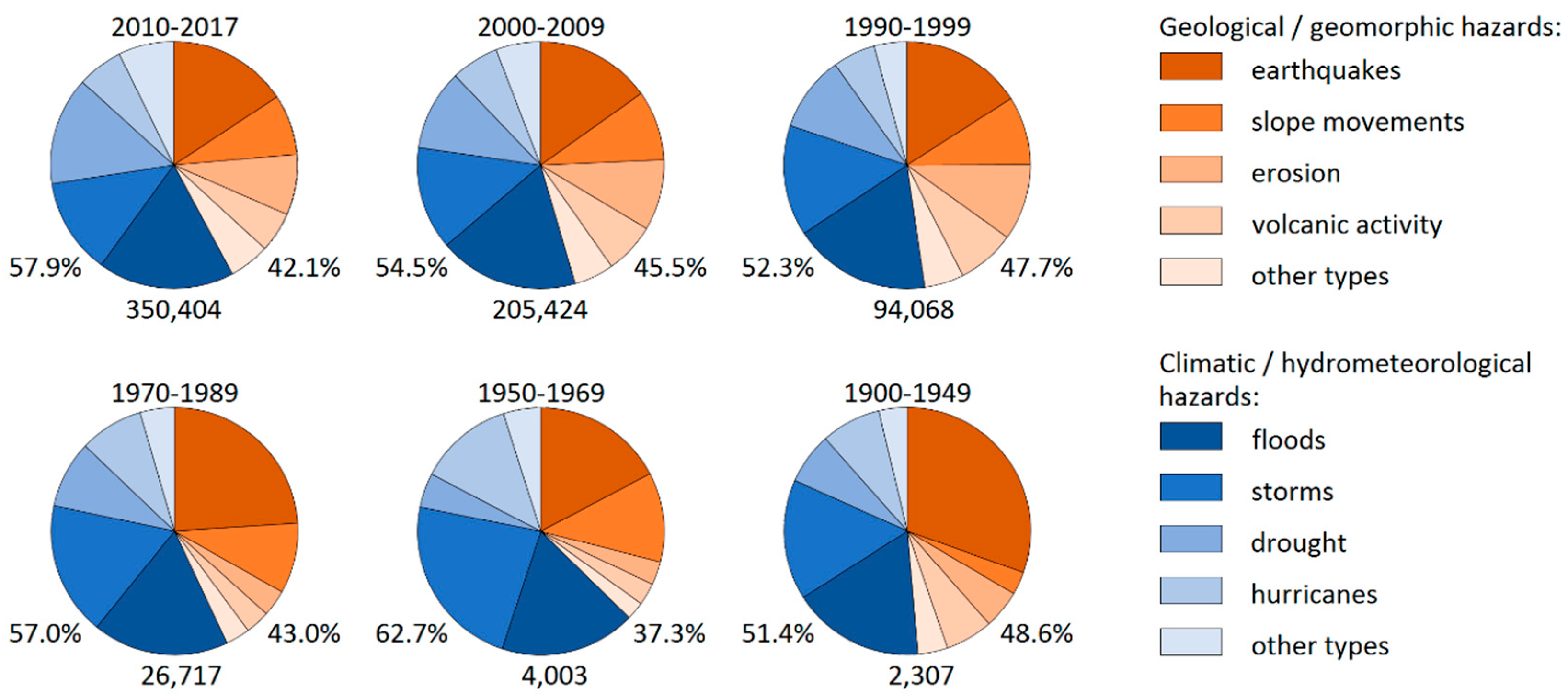
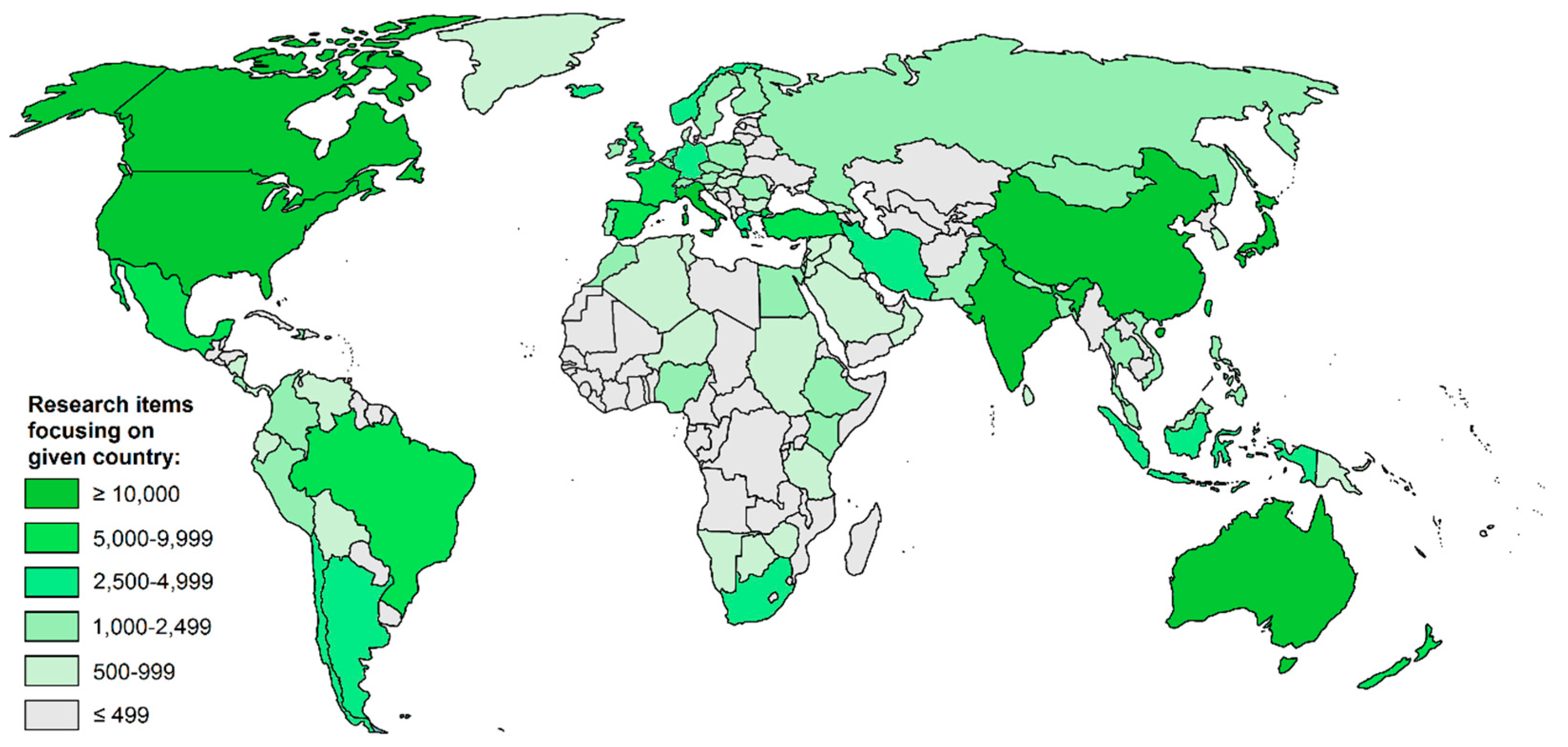
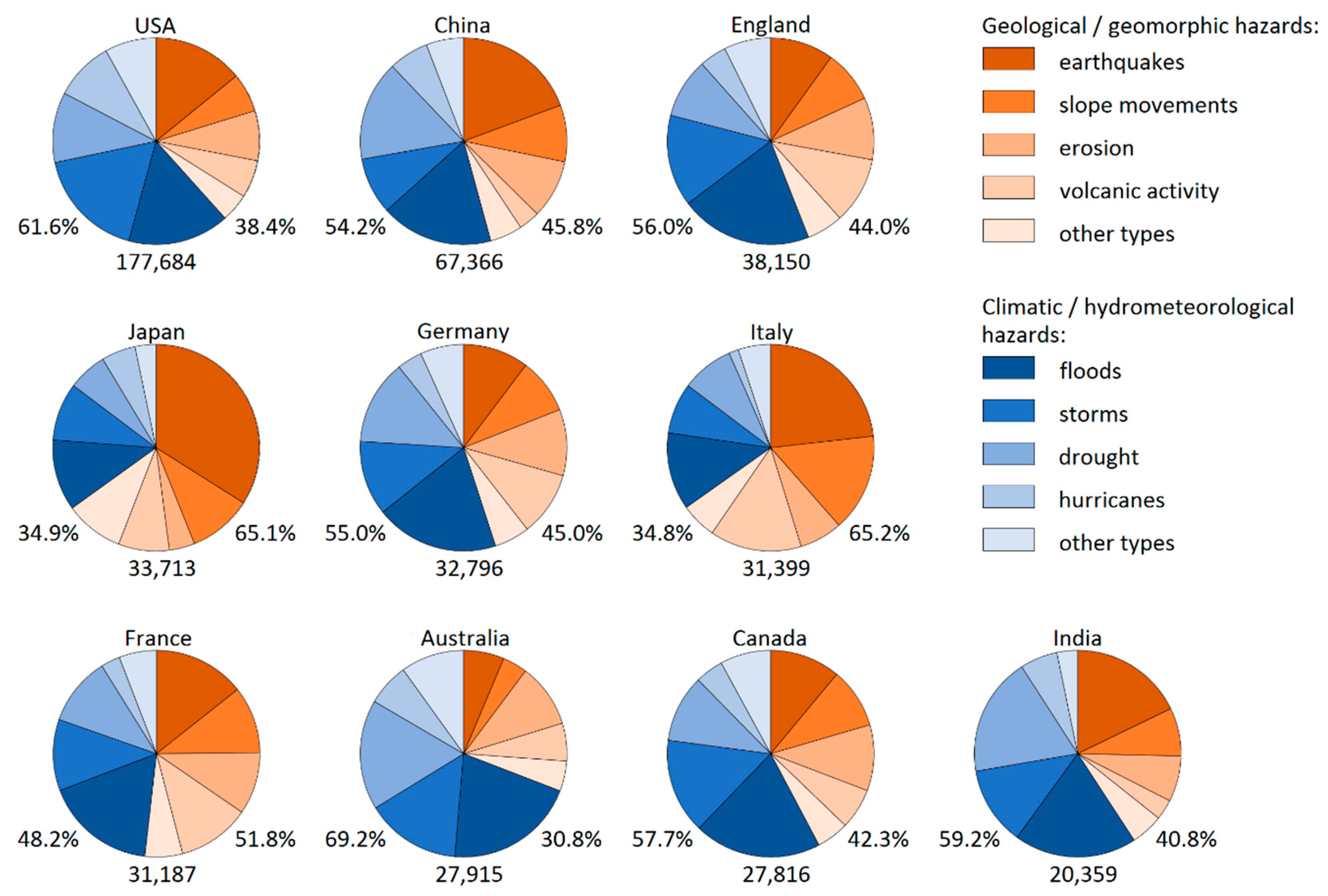
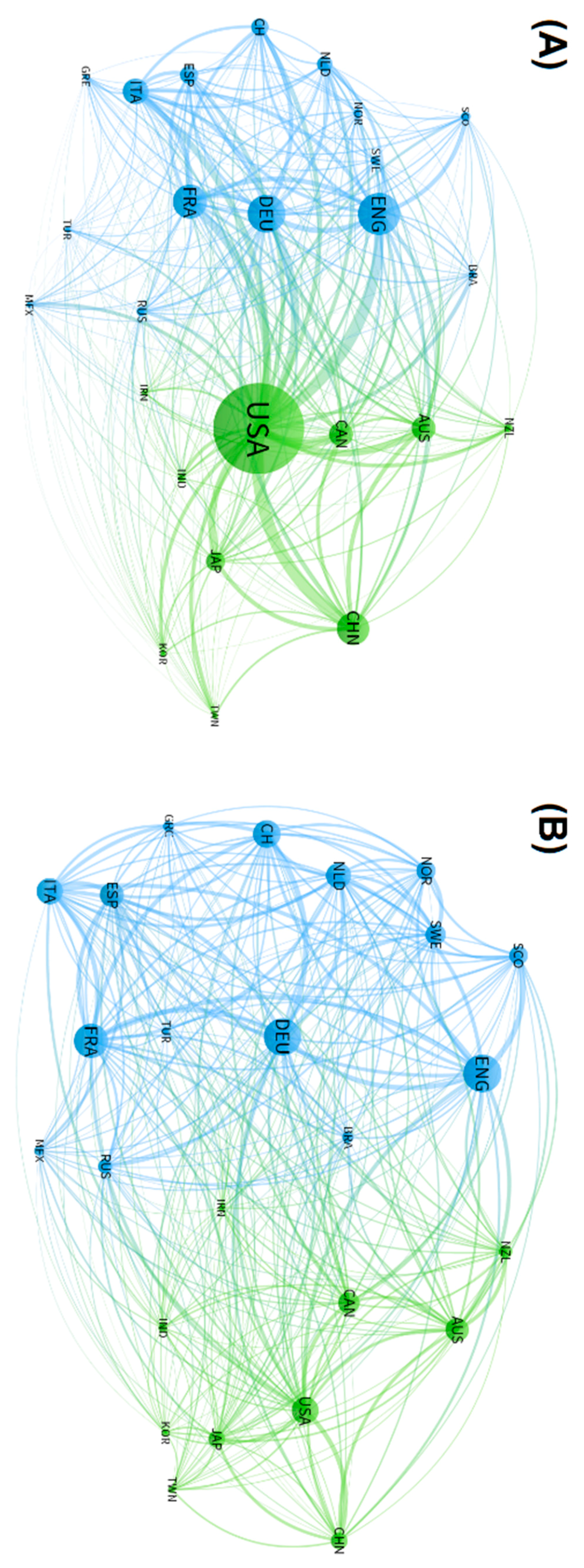
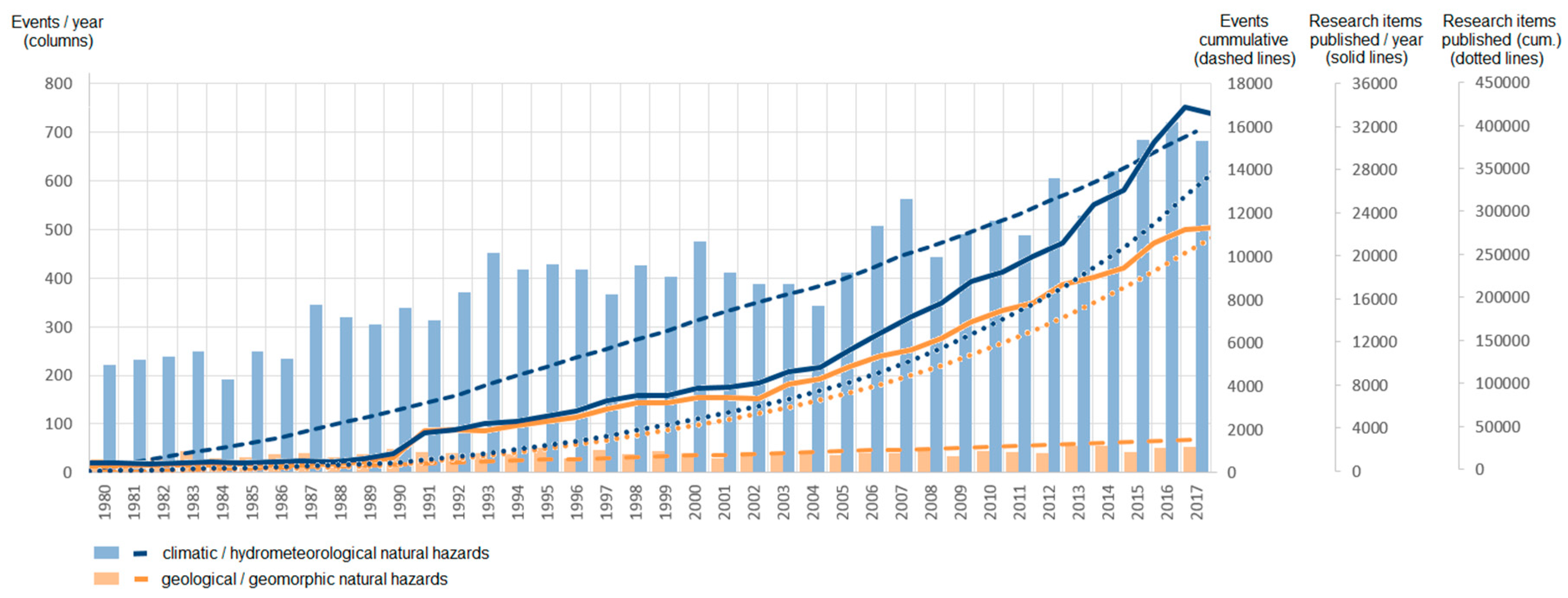
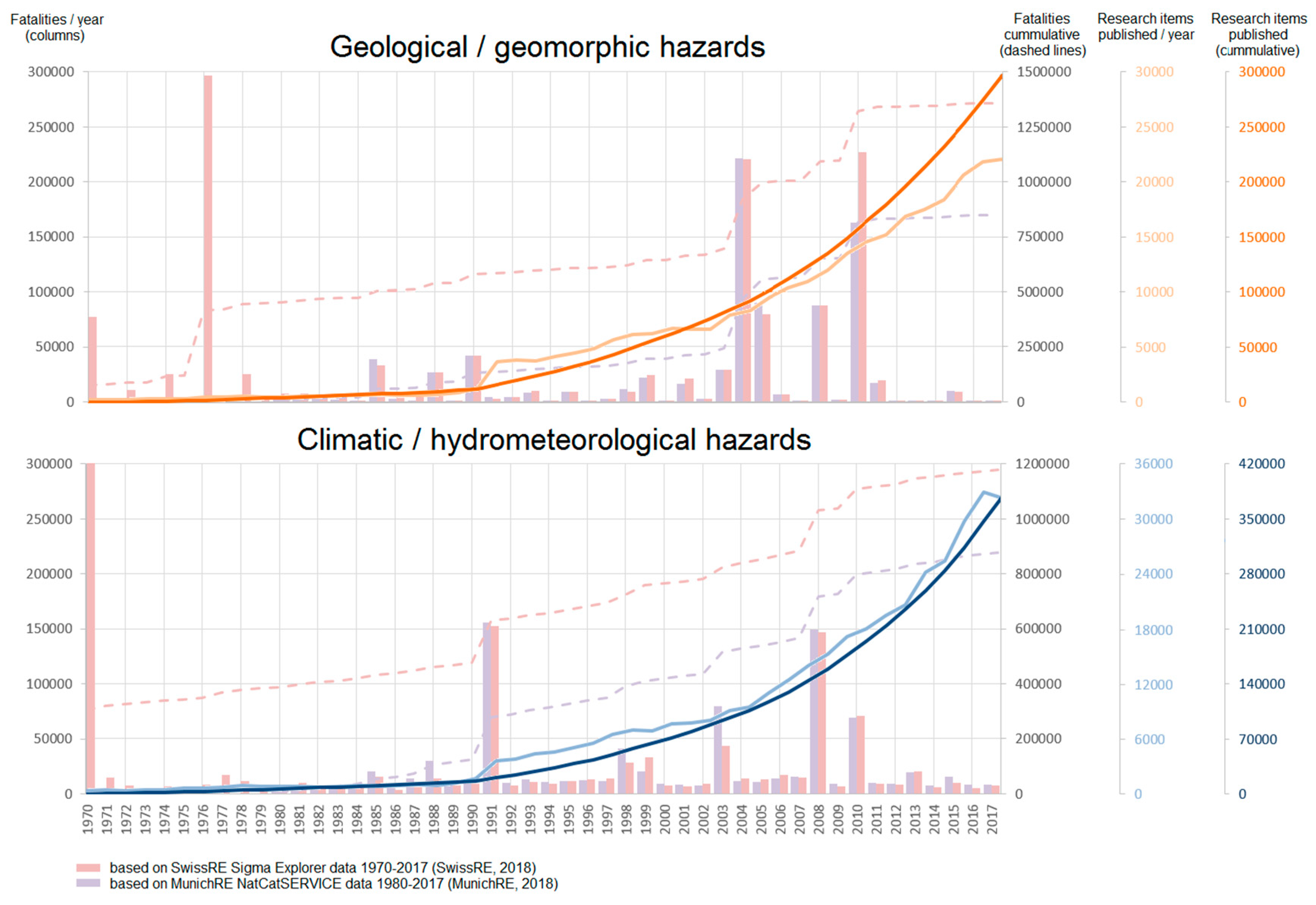
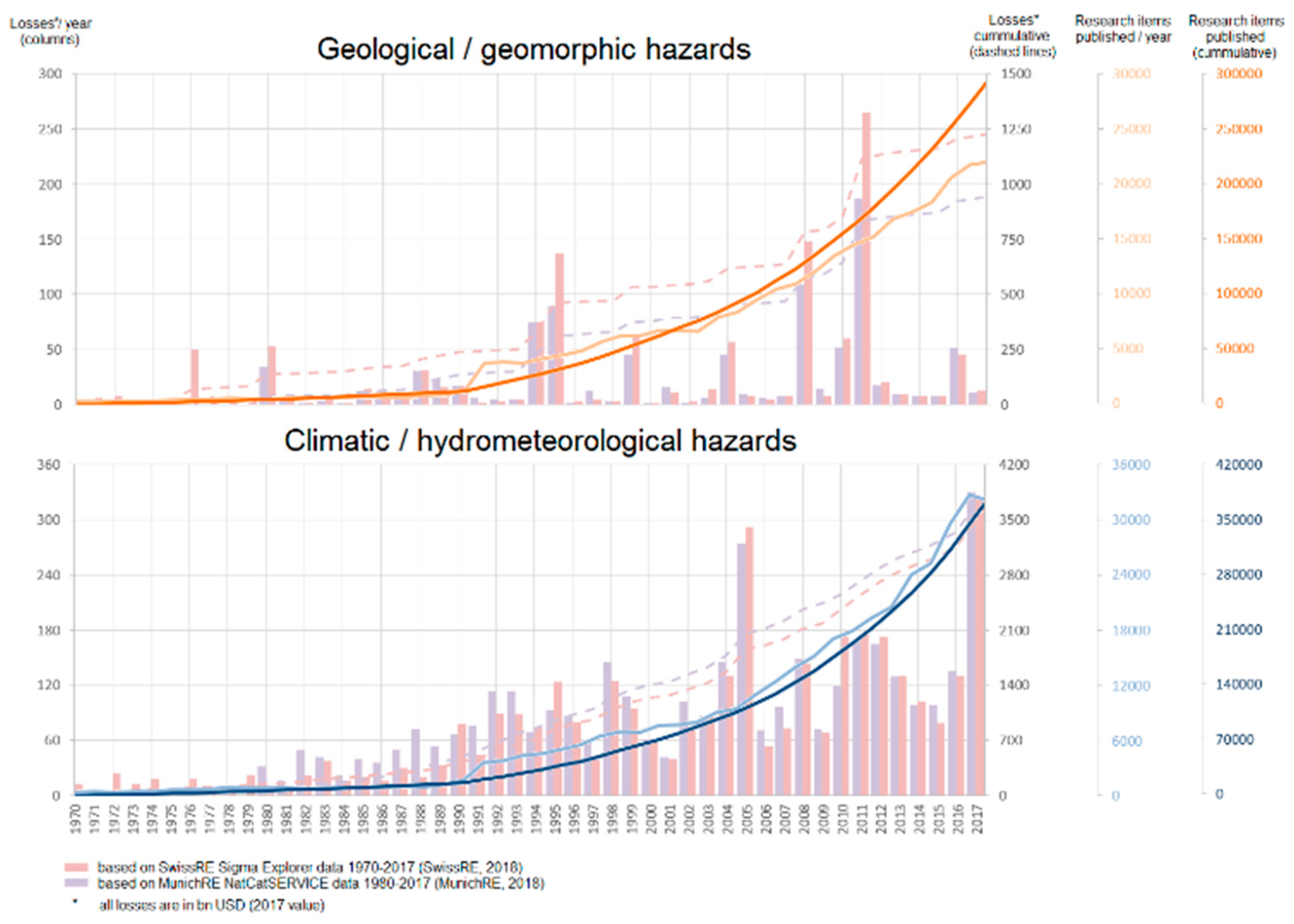
| Categories (Bold) and Types of Natural Hazards | WOS Advanced Search Query Chain # | Research Items Found (1900–2017) |
|---|---|---|
| Climatic/hydro-meteorological | TS = ((flood *) OR (drought * OR (water scarcity)) OR (hurricane * OR typhoon * OR cyclone *) OR (“sea level rise” OR “rising sea level”) OR (wildfire *) OR (desertification) OR (tornado *) OR (“heat wave *” OR heatwave *) OR (dust AND storm *) OR (TS = ((storm * OR (rainfall AND (extreme OR heavy)))) NOT TS = dust) | 342,250 |
| - Flood (FL) | TS = (flood *) | 123,227 |
| - Storm (ST) | TS = (storm * OR (rainfall AND (extreme OR heavy))) NOT TS = (dust) | 91,298 |
| - Drought (DR) | TS = (drought * OR (water scarcity)) | 83,214 |
| - Hurricane (HU) | TS = (hurricane * OR typhoon * OR cyclone *) | 42,097 |
| - Sea level rise (SR) | TS = (“sea level rise” OR “rising sea level”) | 12,725 |
| - Wildfire (WF) | TS = (wildfire *) | 11,086 |
| - Desertification (DE) | TS = (desertification) | 5763 |
| - Heat wave (HW) | TS = (“heat wave *” OR heatwave *) | 4903 |
| - Tornado (TO) | TS = (tornado *) | 4384 |
| - Dust storm (DS) | TS = (dust AND storm *) | 4264 |
| Geological/geomorphic | TS = ((earthquake *) OR ((slope AND movement *) OR landslide * OR avalanche * OR rockfall * OR rockslide * OR “debris flow *”) OR (erosion * AND (soil * OR rock * OR water OR wind)) OR (volcan * AND (activ * OR eruption * OR explos *)) OR (subsidence *) OR (tsunami *)) | 273,459 |
| - Earthquakes (EQ) | TS = (earthquake *) | 109,123 |
| - Slope movements (SM) | TS = ((slope AND movement *) OR landslide * OR avalanche * OR rockfall * OR rockslide * OR “debris flow *”) | 57,846 |
| - Erosion (ER) | TS = (erosion * AND (soil * OR rock * OR water OR wind)) | 57,269 |
| - Volcanic activity (VO) | TS = (volcan * AND (activ * OR eruption * OR explos *)) | 40,469 |
| - Subsidence (SU) | TS = (subsidence *) | 21,777 |
| - Tsunami (TS) | TS = (tsunami *) | 13,478 |
| TOTAL | TS = ((earthquake *) OR ((slope AND movement *) OR landslide * OR avalanche * OR rockfall * OR rockslide * OR “debris flow *”) OR (erosion * AND (soil * OR rock * OR water OR wind)) OR (volcan * AND (activ * OR eruption * OR explos *)) OR (subsidence *) OR (tsunami *) OR (flood *) OR (drought * OR (water scarcity)) OR (hurricane * OR typhoon * OR cyclone *) OR (“sea level rise” OR “rising sea level”) OR (wildfire *) OR (desertification) OR (tornado *) OR (“heat wave *” OR heatwave *) OR (dust AND storm *)) OR (TS = ((storm * OR (rainfall AND (extreme OR heavy)))) NOT TS = dust) | 588,424 |
| Database of Catastrophes | ||
|---|---|---|
| MunichRE NatCatSERVICE | SwissRE Sigma Explorer | |
| Geographical coverage | global | global |
| Time span | 1980–2017 | 1970–2018 |
| No. of events | 17,320 relevant (935 catastrophes) | 5505 (5421 for period 1970–2017) |
| Data used | Number of events, losses and fatalities by natural hazard types and by years | Number of events (cumulative), losses and fatalities by natural hazard types and by years |
| Link | https://natcatservice.munichre.com/ | http://www.sigma-explorer.com/ |
| Reference | [1] | [5] |
| Number of Multi-Hazard Research Items between Two Types of Natural Hazards | |||||||||||
|---|---|---|---|---|---|---|---|---|---|---|---|
| X | EQ | SM | ER | VO | GO | FL | ST | DR | HU | CO | |
| Share of multi-hazard research items between two types of natural hazards [%] | EQ | X | 5299 | 724 | 4189 | 7935 | 2657 | 1403 | 231 | 1742 | 581 |
| SM | 3.3 | X | 3035 | 1959 | 1898 | 1982 | 410 | 170 | 220 | 329 | |
| ER | 0.4 | 2.7 | X | 1307 | 2276 | 3451 | 2501 | 302 | 873 | 549 | |
| VO | 2.9 | 2.0 | 1.4 | X | 1314 | 4829 | 4337 | 1245 | 576 | 3104 | |
| GO | 5.8 | 2.5 | 1.4 | 2.6 | X | 2631 | 1593 | 301 | 1122 | 1490 | |
| FL | 1.2 | 1.9 | 2.7 | 1.2 | 1.7 | X | 10,827 | 6492 | 3865 | 3725 | |
| ST | 0.7 | 1.6 | 2.9 | 0.3 | 1.2 | 5.2 | X | 3307 | 10,104 | 8023 | |
| DR | 0.1 | 0.2 | 0.9 | 0.1 | 0.3 | 3.2 | 1.9 | X | 792 | 2675 | |
| HU | 1.2 | 0.9 | 0.6 | 0.3 | 1.5 | 2.4 | 7.9 | 0.6 | X | 1736 | |
| CO | 0.4 | 0.5 | 3.2 | 0.4 | 2.0 | 2.3 | 6.1 | 2.2 | 2.1 | X | |
| Share of multi-hazard research items [%] | 17.4 | 17.0 | 25.2 | 38.1 | 42.5 | 24.3 | 35.6 | 14.5 | 35.4 | 37.5 | |
| EQ | SM | ER | VO | GO | FL | ST | DR | HU | CO | TOTAL | |
|---|---|---|---|---|---|---|---|---|---|---|---|
| 1. |  |  |  |  |  |  |  |  |  |  |  |
| 2. |  |  |  |  |  |  |  |  |  |  |  |
| 3. |  |  |  |  |  |  |  |  |  |  |  |
| 4. |  |  |  |  |  |  |  |  |  |  |  |
| 5. |  |  |  |  |  |  |  |  |  |  |  |
| 6. |  |  |  |  |  |  |  |  |  |  |  |
| 7. |  |  |  |  |  |  |  |  |  |  |  |
| 8. |  |  |  |  |  |  |  |  |  |  |  |
| 9. |  |  |  |  |  |  |  |  |  |  |  |
| 10. |  |  |  |  |  |  |  |  |  |  |  |
| Categories and Types of Natural Hazards | Research Items Found (1900–2017) | Citations (Total) (1900–2017) | Citations/Item | H Index (8/2018) | i100 Index (8/2018) |
|---|---|---|---|---|---|
| Climatic/hydro-meteorological | 342,250 | 5,884,967 | 17.2 | 494 | 10,603 |
| - Flood (FL) | 123,227 | 1,868,551 | 15.1 | 313 | 3161 |
| - Storm (ST) | 91,298 | 1,501,880 | 16.5 | 301 | 2658 |
| - Drought (DR) | 83,214 | 1,719,385 | 20.7 | 354 | 3478 |
| - Hurricane (HU) | 42,097 | 621,611 | 14.8 | 224 | 1058 |
| - Sea level rise (SR) | 12,725 | 290,771 | 22.9 | 194 | 595 |
| - Wildfire (WF) | 11,086 | 222,717 | 20.1 | 160 | 417 |
| - Desertification (DE) | 5763 | 102,177 | 17.7 | 131 | 209 |
| - Heatwave (HW) | 4903 | 108,654 | 24.8 | 141 | 247 |
| - Tornado (TO) | 4384 | 48,623 | 9.9 | 87 | 67 |
| - Dust storm (DS) | 4264 | 100,621 | 23.6 | 128 | 194 |
| Geological/geomorphic | 273,459 | 4,573,732 | 16.7 | 414 | 7684 |
| - Earthquakes (EQ) | 109,123 | 1,530,718 | 14.0 | 294 | 2587 |
| - Slope movements (SM) | 57,846 | 866,888 | 15.0 | 243 | 1420 |
| - Erosion (ER) | 57,269 | 1,081,608 | 18.9 | 264 | 1824 |
| - Volcanic activity (VO) | 40,469 | 968,054 | 23.9 | 255 | 1794 |
| - Subsidence (SU) | 21,777 | 413,471 | 18.9 | 184 | 659 |
| - Tsunami (TS) | 13,478 | 156,268 | 11.6 | 128 | 228 |
| TOTAL | 588,424 | 9,996,579 | 17.0 | 561 | 17,414 |
© 2018 by the author. Licensee MDPI, Basel, Switzerland. This article is an open access article distributed under the terms and conditions of the Creative Commons Attribution (CC BY) license (http://creativecommons.org/licenses/by/4.0/).
Share and Cite
Emmer, A. Geographies and Scientometrics of Research on Natural Hazards. Geosciences 2018, 8, 382. https://doi.org/10.3390/geosciences8100382
Emmer A. Geographies and Scientometrics of Research on Natural Hazards. Geosciences. 2018; 8(10):382. https://doi.org/10.3390/geosciences8100382
Chicago/Turabian StyleEmmer, Adam. 2018. "Geographies and Scientometrics of Research on Natural Hazards" Geosciences 8, no. 10: 382. https://doi.org/10.3390/geosciences8100382
APA StyleEmmer, A. (2018). Geographies and Scientometrics of Research on Natural Hazards. Geosciences, 8(10), 382. https://doi.org/10.3390/geosciences8100382





